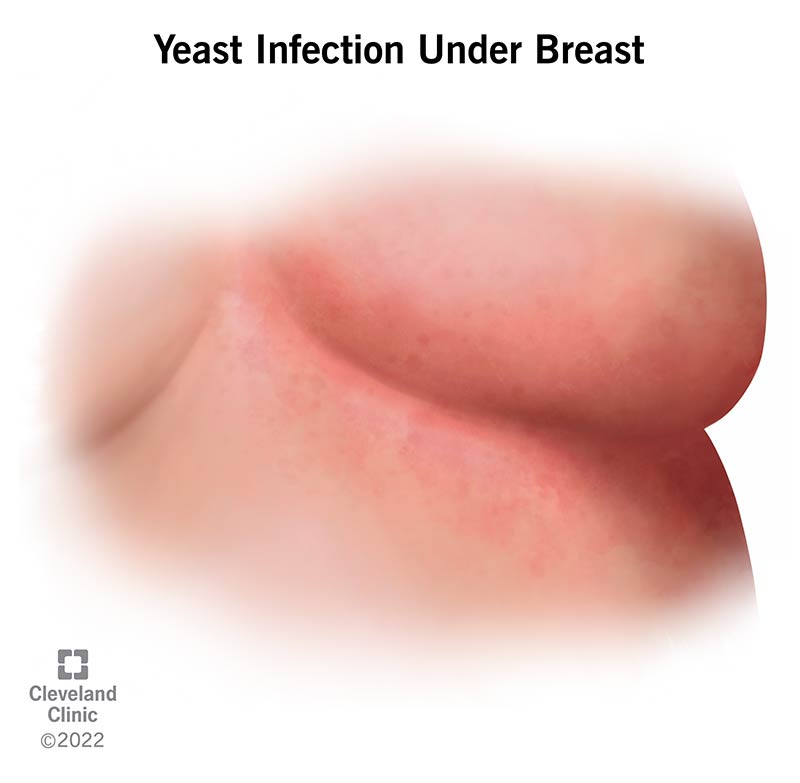Yeast infections under your breasts are a common fungal infection caused by a yeast called Candida. Symptoms include a bright red rash under your breasts and on your upper torso. Treatment includes the use of an antifungal cream or ointment. You can prevent yeast infections by using a drying powder under your breasts.
Advertisement
Cleveland Clinic is a non-profit academic medical center. Advertising on our site helps support our mission. We do not endorse non-Cleveland Clinic products or services. Policy
A yeast infection under your breast is a fungal skin infection called candidiasis. A yeast called Candida causes candidiasis. Many types of yeast naturally live on your skin. In healthy people, this usually doesn’t cause any issues. But when there’s an overgrowth of Candida, the yeast can penetrate the surface of your skin, causing an infection.
Advertisement
Cleveland Clinic is a non-profit academic medical center. Advertising on our site helps support our mission. We do not endorse non-Cleveland Clinic products or services. Policy
Candidiasis can develop almost anywhere on the surface of your body. But it’s most frequently found in moist, warm areas of your skin, such as the skin folds under your breasts.

A yeast infection under your breasts looks like a bright red rash. The rash will appear under your breasts and at the top of your torso where your breast skin touches your chest. The breast rash may be:
The skin around the rash may be dry, flaky and cracked. The rash may produce blisters that crust over and ooze.
A yeast called Candida causes yeast infections under your breasts. Candida grows and thrives in moist, warm environments. When moisture is trapped, it can cause the surface of your skin to stick together in your skin folds. The moisture makes it easier for your skin to rub together, which can lead to a skin condition called intertrigo. Intertrigo allows Candida to overgrow, causing a yeast infection.
Conditions and other factors that can cause intertrigo or lead to yeast infections under your breasts include:
Advertisement
Yeast infections are more common in certain groups of people. This includes people who are:
Yeast infections are also more common in people with weakened immune systems. This may be due to conditions such as diabetes. Or it may be from the use of medications that suppress your immune system.
Your healthcare provider will perform a physical examination to diagnose a yeast infection under your breasts. They may be able to diagnose a yeast infection by looking at the skin under your breasts. If you have a bright red rash, your provider may be able to tell it’s a yeast infection.
Your healthcare provider may want to collect a sample of the rash for testing. They may use a tongue depressor or scalpel to gently scrape some of the skin from the infected area. A pathologist will look at the sample under a microscope. This can help them determine the type of fungus that’s causing the infection.
Treatment for a yeast infection under your breasts may include an antifungal medication. Your healthcare provider may recommend an antifungal cream, ointment or other solution. You can buy many antifungal creams over-the-counter. Your healthcare provider may prescribe a stronger antifungal option if necessary. You can apply antifungals directly onto the infected area of your skin. Topical antifungal medications include:
In some cases, your healthcare provider may recommend an antifungal medication taken by mouth. This includes medications such as fluconazole. They may also recommend a steroid cream to help relieve your symptoms.
It’s important to keep the area under your breasts clean and dry to help get rid of a yeast infection. This can also help prevent yeast infections from returning in the future. Exposing the area under your breasts to air may help. Drying powders may also help dry out your skin and prevent future yeast infections.
You can typically treat yeast infections under your breasts at home. You'll need an over-the-counter antifungal medication. But if the rash doesn’t go away within a couple of weeks, call your healthcare provider. You may need a stronger treatment option.
Be sure to keep the area under your breasts clean and dry to prevent future yeast infections.
It may take a couple of weeks to get rid of a yeast infection under your breasts. After you start antifungal treatment, the rash should start to clear up within a week or two. But yeast infections can be difficult to treat. If your symptoms persist, call your healthcare provider.
You can prevent a yeast infection under your breasts by keeping the area clean and dry. You can also use drying powders to prevent yeast infections. Other steps you can take to prevent yeast infections under your breasts include:
Advertisement
Yeast infections under your breasts are common. You can typically treat them with antifungal medications. But yeast infections under your breasts can take time and patience to get rid of. If you have symptoms of a yeast infection under your breasts, see your healthcare provider. They can give you proper treatment options so you’ll be feeling better as soon as possible.
Advertisement
Cleveland Clinic’s primary care providers offer lifelong medical care. From sinus infections and high blood pressure to preventive screening, we’re here for you.

Last reviewed on 05/09/2022.
Learn more about the Health Library and our editorial process.